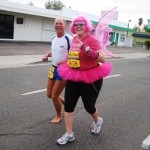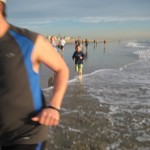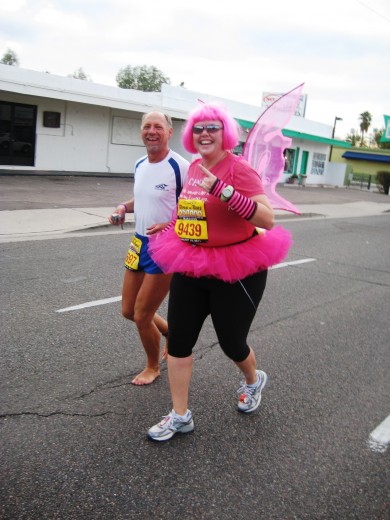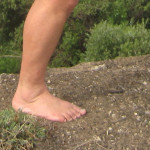Contents
- 1Summary
- 2The Argument against going Barefoot in the Heat
- 3If it's Hot Outside, it's even Hotter Inside (your shoes)
- 4Escapes
- 4.1Made in the shade
- 4.2Lighter colors absorb less heat
- 4.3Leaves of change
- 4.4Rougher terrains hurt less when it's hot
- 4.5Seek cool breeze
- 4.6Get wet
- 4.7Run early
- 4.8Know your climate
- 4.9Run indoors
- 4.10Try not to be stupid
- 4.11Let the soles recover
- 5Early Warnings
- 6Summer-izing our Soles
- 7Videos
- 8Related Links
- 9Gallery

Barefoot Todd completing his 100th barefoot marathon in Phoenix. Asphalt was comfortably cool. Only thing hot, was the redhead running with him!
Summary
I may be getting a bit ahead of myself here, talking to some of you folks back in Michigan and Minnesota, in January, about running barefoot on hot pavement. But, some spring day in a few months, and even sooner here in Southern California, that pavements going to be cooking under the sun all day long, and you’re going to step out of your office, take off your shoes, and go for a run, and possibly burn your feet!
The Argument against going Barefoot in the Heat
I’ve heard some interesting arguments against barefoot running, for example;
“you couldn’t run a full marathon barefoot in Phoenix, Arizona, in July at noon”
The implication being that if you can’t run barefoot in one of the hottest places in the United States, on one of the hottest days of the hottest season, then there’s no point bothering to run barefoot at all!
However, marathons in Phoenix are more likely to be held in January not July. And I don’t think race organizers are thinking about barefoot runners at all when they make those decisions. I think of myself as a reasonable person, and I would not run a marathon in Phoenix in July at noon either, even in shoes!
I should say, “I would not run a marathon in Phoenix in June at noon, ESPECIALLY in shoes!”
If it’s Hot Outside, it’s even Hotter Inside (your shoes)
The average temperature inside shoes is hotter than outside. Our bare feet have 250,000 sweat glands, pumping out a pint of water (on a normal day) to keep our feet cool. This cooling system works wonderfully, until we wrap shoes around our feet.
Bare feet rarely have a problem with air temperature, that is, if we can breath it, our bare feet will probably be fine. It’s those “frying pan” surfaces, especially black asphalt which we need to be careful about how much time our soles stay in contact with … And that’s actually where running, if we’re using good technique (lifting our feet quickly) has an advantage over walking or just standing. Our soles don’t spend much time in contact with the pavement.
Still, if it’s too hot for our bare soles, especially while running, it might be too hot for running, with or without shoes! I’ll talk a bit more about that further down, for now, let’s look at some ways to cope with the heat…
Escapes

Rough terrain, while nearly unbearable in the cold, can be reasonably comfortable on hot days. 115F in St. George Utah, July 2010
There are some ways to work around the heat. We might have noticed while running in the winter, that once in a while we dip into a small gully, and it feels like the temperature dropped 5 or 10 degrees. There is a spot like that on one of the trails I used to run regularly, which we called “the refrigerator”.
Made in the shade
Just because the high temperature is over 100F, or the black asphalt in the sun is over 120F, that doesn’t mean it’s like that every square inch of the area where we live. There may be a tree-lined street or a tall fence along a sidewalk. Take advantage of the shady sides of the streets when necessary.
Lighter colors absorb less heat
Lighter colored surfaces may not be as hot. Look for light grey sidewalks and light colored dirt trails.
Leaves of change
Run through forest trails, or trails that are covered with leaves and grass – but be aware that there may be sharp objects hidden under the leaves. Usually not a big problem in more natural areas, especially if you land very gently.
Rougher terrains hurt less when it’s hot
We shouldn’t limit ourselves to smooth pavement or concrete terrains – in the heat these are actually some of the worse terrains for barefooting, since more of the hot surfaces area will be in direct contact with our soles. Those rough gravel trails that were nearly unbearable during the cold winter, we might find quite delicious for our bare soles on hot days, as there is still plenty of air space between the sharp points that we’re resting on.

Low tide run on the hard-pack sand can be great, But, be mindful of your technique. Running on a comfortable surface can be nearly as deceptive as running in cushy shoes.
Seek cool breeze
Head for the beach. The cool breeze off the ocean can make a huge difference in the temperature of the air, and even for the running surface. Where I live in Huntington Beach California, there is a nice 8-mile asphalt path along the beach which, except possibly late in the afternoon on the hottest days of the summer (when the beach will be too crowded for running anyway) is pretty comfortable most of the time.
Get wet
Run through puddles of water, or even mud too cool off the soles.
Run on grass when the option presents itself. Grass absorbs heat.
If we can get to the beach at low tide, we can run on the hard pack sand in the shallow water – just be sure to mind your technique. Running at the edge of the water at low tide can be so comfortable, it lulls us into that same sense of false security we may have had in cushy running shoes!
Continue to land gently as you would on a rough surface, and we’ll also be less likely to cut our feet on a broken clam shell, or a beer bottle hiding just under the surface. Watch the surface, a fast moving ripple on the surface might indicate a stingray just below the surface… but it’s much easier to just run on the wet sand, rather than ankle deep water anyway.
Run early
Most of my friends in Phoenix, get up and run before the sun rises, like 5:00 AM in the summertime. Even after the sun rises, it generally takes a few hours for the pavement to heat up in most places.
Know your climate
Get to know the micro-climate(s), and especially that of the ground beneath your feet. Figure out where you can run comfortably and when.
Run indoors
Some barefoot runners head for the treadmill in the basement during the winter. There’s no shame, or at least not much shame in using the same strategy to keep cool in the summer.
Try not to be stupid
Know your limitations. A sole burned raw today, won’t be ready to run again for a several days, or even a week. So, avoid too much, too soon. Get off the hot pavement after a short while. Visually check your soles frequently, until you know your limitations better. The less damage we do, the sooner we’ll be able to get back out and run.
Let the soles recover
Even if we don’t have visible burns. Just as we allow (we should be anyway) our muscles time to recover after a run, we should also allow our soles to recover when their limits have been approached or pushed. We might even want to wear (gag!) shoes, or maybe slippers or flip-flops or just socks when we need to walk somewhere shortly after a barefoot run on hot pavement.
Early Warnings
Remember our soles are the proverbial canary in the coal mine, an essential part of our body’s early warning system. Bare soles are extremely sensitive so that they can warn us when we’re running badly, or at a bad time of day, or on the wrong surfaces for that time of day, for too far, too often, and/or too soon. These warnings are not simply to protect our feet from damage. They protect the rest of our body from excess impact or improper torques.
First thing to ask when our soles might get get toasted, “is it too hot for us to run?” Not just for our soles, but for our body. Sometimes we simply should concede that running in extremely hot weather might not be something our body is ready for, yet. Our soles are simply trying to warn us to avoid too much, too hot, too soon.
Other times, like on very sunny spring days, the pavement can become much hotter than the overall weather would indicate, and our body may feel very comfortable, despite what our soles are telling us. But, still we should be mindful of our soles. We might want them intact later!
There are limits to what our bare soles can do. And that isn’t a bad thing. It is usually a warning to prevent us from doing “stupid” things. But, that doesn’t mean that we are simply incapable of extending those limits by improving our technique, and running smarter, or building up gradually over time, or that our feet are inadequate – that would be like saying that quality control inspectors are “too sensitive” because they don’t like it when we ship defective products from our factories to our customers. It’s not that the quality control inspectors want to limit production. They simply want each product to meet specific requirements so the customers are satisfied, and also not suffer injury due to defective product!
We, our bodies, are the customers of our running. Each step carries our body, but when done badly, or too much, without concern for our early warning system (our bare soles) serious damage can result over time, not just to our sensitive soles, but to our body.
Summer-izing our Soles
That warning stated, each summer, there will be days in which the pavement becomes very hot, compared to other days in spring, and some of those days, the weather might not be nearly as hot as the pavement. On days when the pavement is hot, limit how far you run, but don’t avoid the hot pavement all-together, as there is some conditioning (re-conditioning) needed each spring/summer season – what some of us call “summer-izing” our soles.
As with any new activity – specifically, running barefoot on hot surfaces – which we may not have done for several months (over the winter, perhaps), conditioning our soles for running barefoot on hot surfaces will take time, several outings, and patience We should be careful to limit these outings to avoid blistering. While we may be able to “endure” a much longer run suffering through what may be minor blisters, it takes much longer after blistering our soles, before we’ll be ready to run comfortably again.
By June (or July depending on our climate), or December (depending on our hemisphere), if we’re using good technique (especially fast cadence), our bare soles should be able to run reasonable distances at reasonable times of the day without damage.
There also seems to be a tissue memory for conditioning. Just as it’s easier to get fit when we have been fit in our past, over the years, the summer-izing of our soles can occur in progressively shorter and shorter periods each spring.
Videos
Some days, we should just go for a swim, instead of running… Psycho Herman cooling off in Phoenix @ 105F, in May 2008:
Related Links
Gallery
- Barefoot Todd completing his 100th barefoot marathon in Phoenix. Asphalt was comfortably cool. Only thing hot, was the redhead!
- Psycho Herman knows to relax and look for shade when the temperature is 105F
- Rough terrain, while nearly unbearable in the cold, can be reasonably comfortable on hot days. 115F in St. George Utah, July 2010
- Low tide run on the hard-pack sand can be great, But, be mindful of your technique. Running on a comfortable surface can be nearly as deceptive as running in cushy shoes.



Let’s be real: if you can’t stand on the hottest surface for as long as possible without needing a shade patch, you can’t walk on it for very long. If you can’t walk on the hottest surface for as long as possible, you can’t run on it for very long. Otherwise, the soles will burn sharply at the minimum (to the point of the soles tingling from the burning), or they will blister (sharp pinching sensation followed by blisters). Sure, burning and even blistering is an expected part of summerizing the soles, but there is a limit to how summerized the soles can be without otherwise seriously burning them over and over again before they are fully summerized to that much extreme heat.
More to the point: at temperatures above 100 degrees, with whatever the heat index may be, for afternoon times of day–the asphalt is not 120 degrees (no problem), but well over 140 degrees (where untoughened skin burns) and probably near 160 to 200 degrees range (blistering hot). Heat tolerance of the feet has to be determined from the hottest surface to be tolerated without having to resort to shade patches, white lines, etc.
That is what they mean by “you couldn’t run a full marathon barefoot in Phoenix, Arizona, in July at noon”. You’d otherwise require several rounds of sole blisters, then healing them–second degree blisters at the minimum, if not third degree burn blisters–before the feet were fully summerized for that much heat. Then there is the factor that Phoenix is actually the hottest around 5:00pm.
All of the suggestions of avoiding heat are, unfortunately, just showing the limitations of summer barefoot running. It doesn’t mean it can’t be done, but the limitation is the feet heat tolerance for the ambient air temperature, heat index for the time of day, and the hottest possible surface to be run on.
I strongly disagree with the first paragraph. There is a huge difference between standing, walking, and running barefoot on hot surfaces.
I have run very comfortably on pavement that was uncomfortably hot while walking, and probably intolerably hot while standing.
And summerizing the soles does NOT require burning or blistering. Much like sun-tanning does not require burning. The trick is no trick, it’s just a matter of being reasonable knowing your current limits and building gradually.
Facts:
Standing: both feet are in contact with pavement 100% of time
Walking: one foot, or the other, or both are in contact with ground at any given point of stride (each foot is in contact with pavement more than 50% of time)
Running: both feet are off the ground at some point of stride (each foot is in contact with pavement less than 50% of time)
In addition, while running, one foot is flying through the air twice as fast as our body is moving forward. This generates an air-speed of 10-20 MPH which works with the 250,000 sweat glands in our feet, pumping moisture to the surface of our feet, where this wind effect evaporates the sweat, removing heat very efficiently (stay hydrated).
I’ve no doubt it gets too hot to run comfortably barefoot some of the time in Phoenix. But the reality is that most of us don’t live in Phoenix, and no one in Phoenix “NEEDS” to run at noon, at least no one with any sense would, at least not on blacktop in the sunlight.